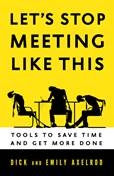Now that summer is over, meeting-season is in full swing. And that’s not good news to most people. Given how much time most people spend in meetings, how can they be made more productive and useful? That’s the subject of a terrific new book, Let’s Stop Meeting Like This, by Dick and Emily Axelrod of The Axelrod Group.

I’ve gotten to know Dick and Emily during the past five years through the Berrett-Koehler Authors Cooperative, and my conversations with them are always personal highlight at the annual authors retreat. I asked Dick to elaborate on some of the book’s major points:
1. Can you briefly outline the concept of The Meeting Canoe™, and why it is relevant for all types of organizations?
The Meeting Canoe™ provides a framework for creating the kinds of conversations that occur in successful meetings. It consists of six parts:
• Welcome people–Create an atmosphere that is conducive to doing the meeting’s work.
• Connect people to each other and the task–Create two levels of connection: the first level is building relationships between meeting participants, and the second level is connecting meeting participants to the task at hand.
• Discover the way things are–Engage people in learning for themselves about the current situation.
• Elicit people’s dreams–Have participants imagine their preferred future.
• Decide– People make decisions about what they want to do based on the way things are and their hopes for the future.
• Attend to the end– Bring closure to the meeting by reviewing decisions made, determining who is responsible for carrying them out, identifying next steps, and reflecting on the meeting process.
For the past twenty years, we have field tested the Meeting Canoe with organizations large and small in both the not-for-profit world and the for-profit world. Increasingly, these organizations need an effective way to bring people together to do work. The Meeting Canoe provides a simple, easy-to-use framework for them.

2. Just the mention of the word ‘meeting’ is enough to put someone in a bad mood. Why has this become the case, and why have we not been able to devise better strategies for effective meetings after all these years of knowledge work?
Meetings get a bad rap because they are perceived as taking people away from “their work,” and meeting participants feel that time spent in meetings is not productive. Meetings must become places where you can get your work done as well as the organization’s work done.
An efficiency mindset pervades the way we conduct meetings, i.e. shorter and fewer meetings. Moving through the agenda quickly and reducing the number of meetings becomes the goal rather than getting work done. All this mindset does is shorten and reduce the number of dysfunctional meetings. It does nothing to improve meeting quality.
We need to create meetings that are productive work experiences. Participants in these meetings experience:
Autonomy – The ability to influence the meeting’s design and its outcome
Challenge – The prospect of stretching your skills
Learning – The opportunity to learn and grow
Meaning – The chance to work on something that is important
Feedback – The capability of measuring the meeting’s progress
3. Are the principles in your book mainly for people who lead meetings and have managerial responsibility, or can other attendees benefit as well?
In today’s organizations, you are often a meeting leader in one meeting and a meeting contributor in another. The question for anyone who is part of a meeting is, “Are you going to be a meeting bystander and watch the meeting go downhill, or are you going to become a meeting investor and contribute to the meeting’s effectiveness?” The principles in our book help people become better meeting investors no matter what their role.
